load capacity KIA Soul 2013 1.G Owner's Manual
[x] Cancel search | Manufacturer: KIA, Model Year: 2013, Model line: Soul, Model: KIA Soul 2013 1.GPages: 393, PDF Size: 8.76 MB
Page 11 of 393
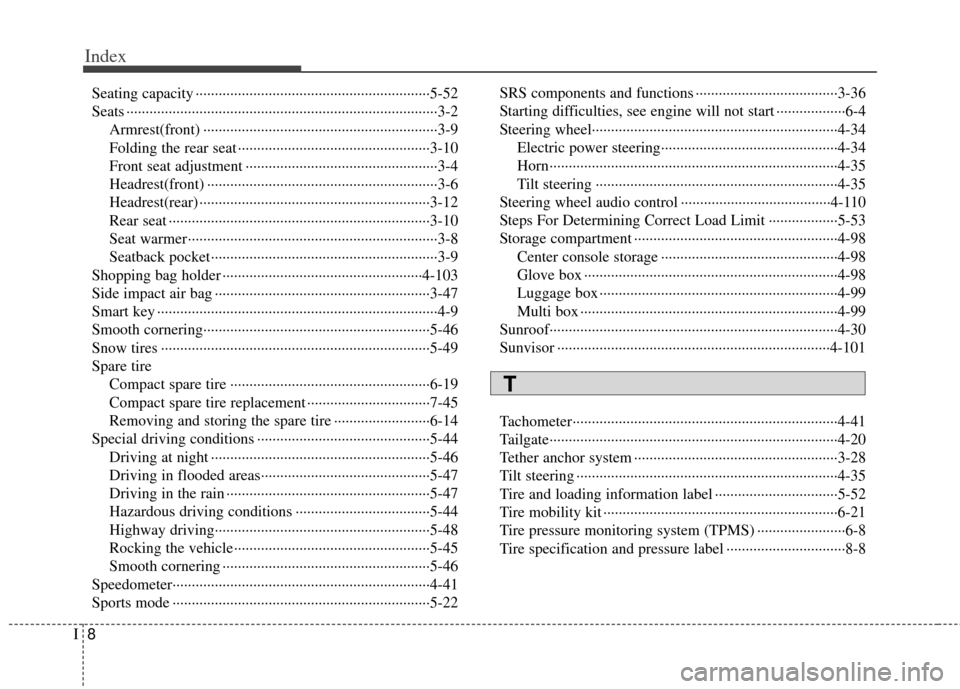
Index
8I
Seating capacity ··················\
··················\
··················\
·······5-52
Seats ··················\
··················\
··················\
··················\
·········3-2Armrest(front) ··················\
··················\
··················\
·······3-9
Folding the rear seat ··················\
··················\
··············3-10
Front seat adjustment ··················\
··················\
··············3-4
Headrest(front) ··················\
··················\
··················\
······3-6
Headrest(rear) ··················\
··················\
··················\
······3-12
Rear seat ··················\
··················\
··················\
··············3-10
Seat warmer··················\
··················\
··················\
···········3-8
Seatback pocket··················\
··················\
··················\
·····3-9
Shopping bag holder ··················\
··················\
················4-103
Side impact air bag ··················\
··················\
··················\
··3-47
Smart key ··················\
··················\
··················\
··················\
·4-9
Smooth cornering··················\
··················\
··················\
·····5-46
Snow tires ··················\
··················\
··················\
················5-49
Spare tire Compact spare tire ··················\
··················\
················6-19
Compact spare tire replacement ··················\
··············7-45
Removing and storing the spare tire ··················\
·······6-14
Special driving conditions ··················\
··················\
·········5-44 Driving at night ··················\
··················\
··················\
···5-46
Driving in flooded areas··················\
··················\
········5-47
Driving in the rain ··················\
··················\
·················5-47\
Hazardous driving conditions ··················\
·················5-44\
Highway driving··················\
··················\
··················\
··5-48
Rocking the vehicle··················\
··················\
···············5-45
Smooth cornering ··················\
··················\
··················\
5-46
Speedometer··················\
··················\
··················\
·············4-41
Sports mode ··················\
··················\
··················\
·············5-22 SRS components and functions ··················\
··················\
·3-36
Starting difficulties, see engine will not start ··················\
6-4
Steering wheel···············\
··················\
··················\
·············4-34
Electric power steering··················\
··················\
··········4-34
Horn··················\
··················\
··················\
··················\
···4-35
Tilt steering ··················\
··················\
··················\
·········4-35
Steering wheel audio control ··················\
··················\
···4-110
Steps For Determining Correct Load Limit ··················\
5-53
Storage compartment ··················\
··················\
·················4-98\
Center console storage ··················\
··················\
··········4-98
Glove box ··················\
··················\
··················\
············4-98
Luggage box ··················\
··················\
··················\
········4-99
Multi box ··················\
··················\
··················\
·············4-99
Sunroof··················\
··················\
··················\
··················\
···4-30
Sunvisor ··················\
··················\
··················\
·················4-10\
1
Tachometer··················\
··················\
··················\
···············4-41
Tailgate··················\
··················\
··················\
··················\
···4-20
Tether anchor system ··················\
··················\
·················3-28\
Tilt steering ··················\
··················\
··················\
··············4-35
Tire and loading information label ··················\
··············5-52
Tire mobility kit ··················\
··················\
··················\
·······6-21
Tire pressure monitoring system (TPMS) ··················\
·····6-8
Tire specification and pressure label ··················\
·············8-8
T
Page 12 of 393

I9
Index
Tires and wheels ··················\
··················\
·················7-41\
, 8-3Checking tire inflation pressure ··················\
··············7-42
Compact spare tire replacement ··················\
··············7-45
Recommended cold tire inflation pressures ··············7-41
Tire care··················\
··················\
··················\
···············7-41
Tire maintenance ··················\
··················\
··················\
·7-46
Tire replacement ··················\
··················\
··················\
··7-45
Tire rotation ··················\
··················\
··················\
·········7-43
Tire sidewall labeling ··················\
··················\
············7-46
Tire traction ··················\
··················\
··················\
·········7-46
Wheel alignment and tire balance ··················\
···········7-44
Wheel replacement ··················\
··················\
················7-46
Towing ··················\
··················\
··················\
··················\
···6-27
Towing capacity ··················\
··················\
··················\
·······5-53
Transaxle Automatic transaxle ··················\
··················\
··············5-20
Manual transaxle ··················\
··················\
··················\
·5-17
Trip computer ··················\
··················\
··················\
··········4-44 Vehicle break-in process ··················\
··················\
··············1-5
Vehicle capacity weight ··················\
··················\
·············5-52
Vehicle certification label ··················\
··················\
············8-7
Vehicle curb weight ··················\
··················\
··················\
·5-57
Vehicle handling instruncions··················\
··················\
······1-5
Vehicle identification number (VIN) ··················\
·············8-7
Vehicle load limit ··················\
··················\
··················\
·····5-52
Cargo capacity ··················\
··················\
··················\
·····5-53
Certification label ··················\
··················\
··················\
5-55
Seating capacity ··················\
··················\
··················\
··5-52
Steps For Determining Correct Load Limit ··············5-53
Tire and loading information label··················\
··········5-52
Towing capacity ··················\
··················\
··················\
··5-53
Vehicle capacity weight ··················\
··················\
········5-52
Vehicle stability management ··················\
··················\
····5-34
Vehicle weight ··················\
··················\
··················\
·········5-57 Base curb weight ··················\
··················\
··················\
·5-57
Cargo weight ··················\
··················\
··················\
·······5-57
GAW (Gross axle weight) ··················\
··················\
·····5-57
GAWR (Gross axle weight rating)··················\
··········5-57
GVW (Gross vehicle weight)··················\
··················\
5-57
GVWR (Gross vehicle weight rating) ··················\
····5-57
Vehicle curb weight··················\
··················\
···············5-57
Volume/weight ··················\
··················\
··················\
···········8-3V
Page 267 of 393
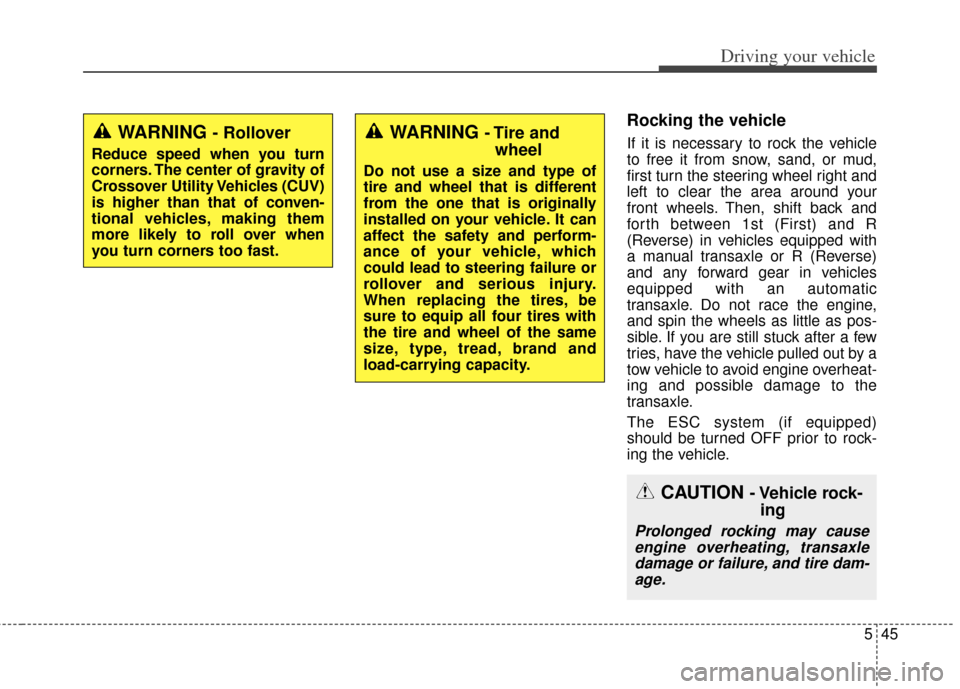
545
Driving your vehicle
Rocking the vehicle
If it is necessary to rock the vehicle
to free it from snow, sand, or mud,
first turn the steering wheel right and
left to clear the area around your
front wheels. Then, shift back and
forth between 1st (First) and R
(Reverse) in vehicles equipped with
a manual transaxle or R (Reverse)
and any forward gear in vehicles
equipped with an automatic
transaxle. Do not race the engine,
and spin the wheels as little as pos-
sible. If you are still stuck after a few
tries, have the vehicle pulled out by a
tow vehicle to avoid engine overheat-
ing and possible damage to the
transaxle.
The ESC system (if equipped)
should be turned OFF prior to rock-
ing the vehicle.WARNING - Rollover
Reduce speed when you turn
corners. The center of gravity of
Crossover Utility Vehicles (CUV)
is higher than that of conven-
tional vehicles, making them
more likely to roll over when
you turn corners too fast.
WARNING - Tire andwheel
Do not use a size and type of
tire and wheel that is different
from the one that is originally
installed on your vehicle. It can
affect the safety and perform-
ance of your vehicle, which
could lead to steering failure or
rollover and serious injury.
When replacing the tires, be
sure to equip all four tires with
the tire and wheel of the same
size, type, tread, brand and
load-carrying capacity.
CAUTION - Vehicle rock- ing
Prolonged rocking may cause
engine overheating, transaxledamage or failure, and tire dam-age.
Page 274 of 393

Driving your vehicle
52
5
Tire and loading information
label
The label located on the driver's door
sill gives the original tire size, cold
tire pressures recommended for your
vehicle, the number of people that
can be in your vehicle and vehicle
capacity weight.
Vehicle capacity weight:
385 kg (849 lbs.)
Vehicle capacity weight is the maxi-
mum combined weight of occupants
and cargo. If your vehicle is equipped
with a trailer, the combined weight
includes the tongue load.
Seating capacity:
Total : 5 persons (Front seat : 2 persons, Rear seat : 3 persons)
Seating capacity is the maximum
number of occupants including a
driver, your vehicle may carry.
However, the seating capacity may
be reduced based upon the weight of
all of the occupants, and the weight
of the cargo being carried or towed.
VEHICLE LOAD LIMIT
■ Type B
■
Type A
■ Type C■Type E
■
Type D
■ Type F
OAM050200N/OAM050101L/OAM050102L OAM052201N/OAM052202N/OAM052203N
Page 275 of 393
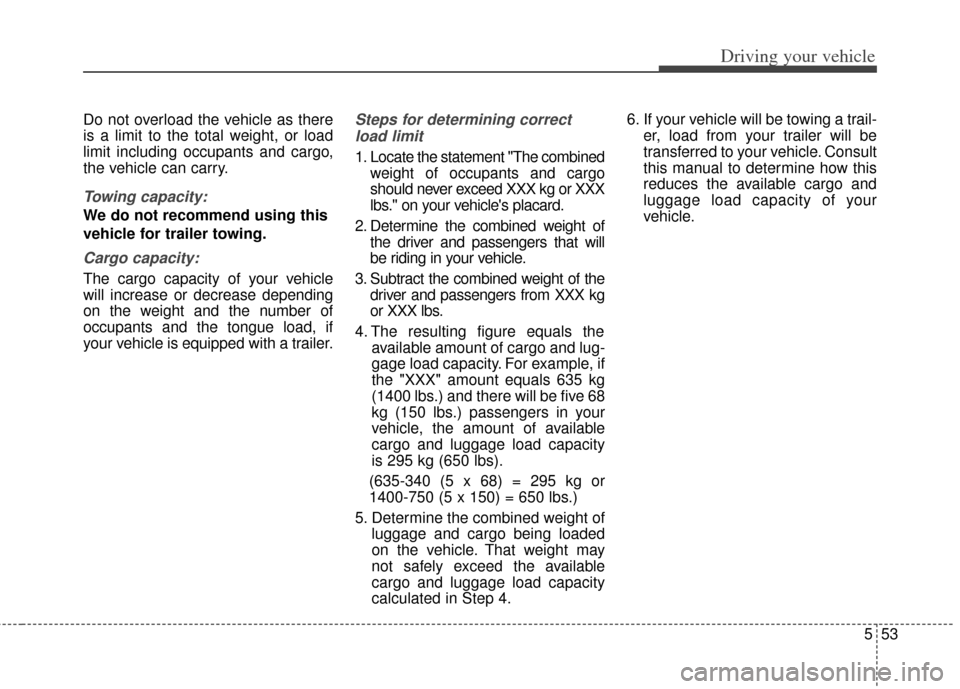
553
Driving your vehicle
Do not overload the vehicle as there
is a limit to the total weight, or load
limit including occupants and cargo,
the vehicle can carry.
Towing capacity:
We do not recommend using this
vehicle for trailer towing.
Cargo capacity:
The cargo capacity of your vehicle
will increase or decrease depending
on the weight and the number of
occupants and the tongue load, if
your vehicle is equipped with a trailer.
Steps for determining correctload limit
1. Locate the statement "The combined weight of occupants and cargo
should never exceed XXX kg or XXX
lbs.'' on your vehicle's placard.
2. Determine the combined weight of the driver and passengers that will
be riding in your vehicle.
3. Subtract the combined weight of the driver and passengers from XXX kg
or XXX lbs.
4. The resulting figure equals the available amount of cargo and lug-
gage load capacity. For example, if
the "XXX" amount equals 635 kg
(1400 lbs.) and there will be five 68
kg (150 lbs.) passengers in your
vehicle, the amount of available
cargo and luggage load capacity
is 295 kg (650 lbs).
(635-340 (5 x 68) = 295 kg or
1400-750 (5 x 150) = 650 lbs.)
5. Determine the combined weight of luggage and cargo being loaded
on the vehicle. That weight may
not safely exceed the available
cargo and luggage load capacity
calculated in Step 4. 6. If your vehicle will be towing a trail-
er, load from your trailer will be
transferred to your vehicle. Consult
this manual to determine how this
reduces the available cargo and
luggage load capacity of your
vehicle.
Page 276 of 393
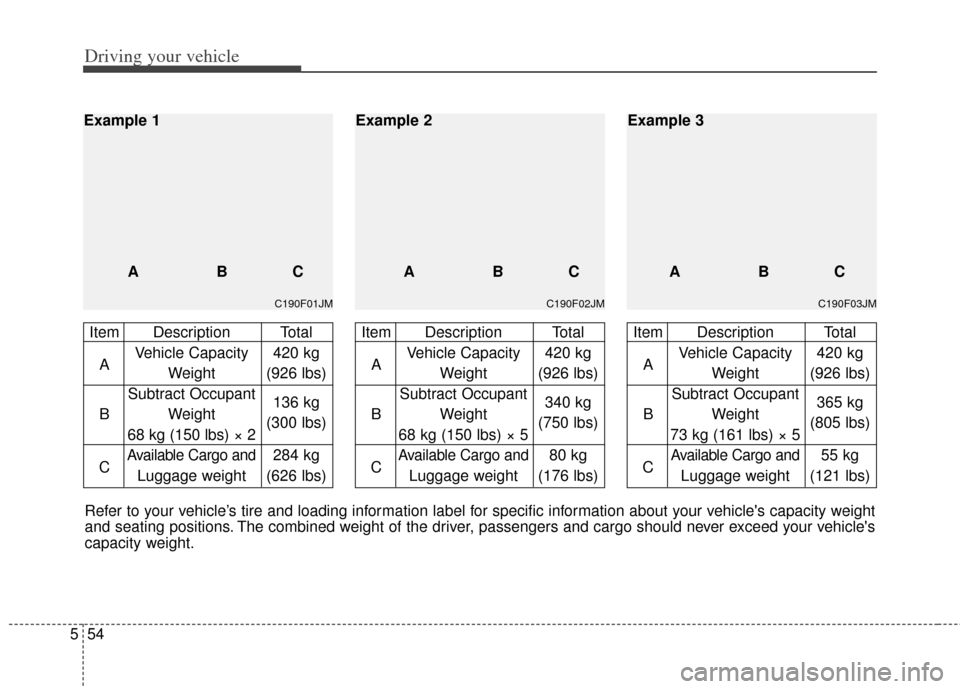
Driving your vehicle
54
5
C190F03JM
Item Description Total
A Vehicle Capacity 420 kg
Weight (926 lbs)
Subtract Occupant
B Weight 365 kg
73 kg (161 lbs) × 5 (805 lbs)
C
Available Cargo and55 kg
Luggage weight (121 lbs)
ABC
Example 3
C190F02JM
Item Description Total
A Vehicle Capacity 420 kg
Weight (926 lbs)
Subtract Occupant
B Weight 340 kg
68 kg (150 lbs) × 5 (750 lbs)
C
Available Cargo and80 kg
Luggage weight (176 lbs)
ABC
Example 2
C190F01JM
Item Description Total
A Vehicle Capacity 420 kg
Weight (926 lbs)
Subtract Occupant
B Weight 136 kg
68 kg (150 lbs) × 2 (300 lbs)
C
Available Cargo and284 kg
Luggage weight (626 lbs)
Example 1
ABC
Refer to your vehicle’s tire and loading information label for specific information about your vehicle's capacity weight
and seating positions. The combined weight of the driver, passengers and cargo should never exceed your vehicle's
capacity weight.
Page 277 of 393

555
Driving your vehicle
Certification label
The certification label is located on
the driver's door sill at the center pil-
lar.
This label shows the maximum
allowable weight of the fully loaded
vehicle. This is called the GVWR
(Gross Vehicle Weight Rating). The
GVWR includes the weight of the
vehicle, all occupants, fuel and
cargo.
This label also tells you the maxi-
mum weight that can be supported
by the front and rear axles, called
Gross Axle Weight Rating (GAWR).
To find out the actual loads on your
front and rear axles, you need to go
to a weigh station and weigh your
vehicle. Your dealer can help you with
this. Be sure to spread out your load
equally on both sides of the center-
line.The label will help you decide how
much cargo and installed equipment
your vehicle can carry.
If you carry items inside your vehicle
- like suitcases, tools, packages, or
anything else - they are moving as
fast as the vehicle. If you have to stop
or turn quickly, or if there is a crash,
the items will keep going and can
cause an injury if they strike the driv-
er or a passenger.WARNING - Over load-
ing
Never exceed the GVWR for
your vehicle, the GAWR for
either the front or rear axle and
vehicle capacity weight.
Exceeding these ratings can
affect your vehicle’s handling
and braking ability.
WARNING - Over load-ing
Do not overload your vehicle.
Overloading your vehicle can
cause heat buildup in your vehi-
cle's tires and possible tire fail-
ure, increased stopping dis-
tances and poor vehicle han-
dling--all of which may result in
a crash.
Page 298 of 393
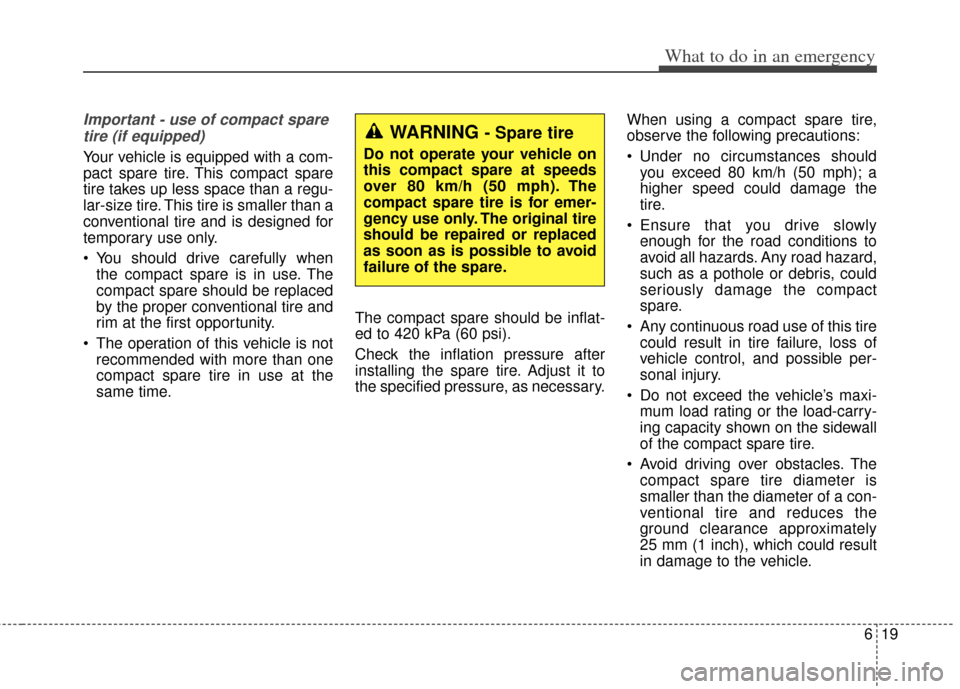
619
What to do in an emergency
Important - use of compact sparetire (if equipped)
Your vehicle is equipped with a com-
pact spare tire. This compact spare
tire takes up less space than a regu-
lar-size tire. This tire is smaller than a
conventional tire and is designed for
temporary use only.
You should drive carefully when the compact spare is in use. The
compact spare should be replaced
by the proper conventional tire and
rim at the first opportunity.
The operation of this vehicle is not recommended with more than one
compact spare tire in use at the
same time. The compact spare should be inflat-
ed to 420 kPa (60 psi).
Check the inflation pressure after
installing the spare tire. Adjust it to
the specified pressure, as necessary. When using a compact spare tire,
observe the following precautions:
Under no circumstances should
you exceed 80 km/h (50 mph); a
higher speed could damage the
tire.
Ensure that you drive slowly enough for the road conditions to
avoid all hazards. Any road hazard,
such as a pothole or debris, could
seriously damage the compact
spare.
Any continuous road use of this tire could result in tire failure, loss of
vehicle control, and possible per-
sonal injury.
Do not exceed the vehicle’s maxi- mum load rating or the load-carry-
ing capacity shown on the sidewall
of the compact spare tire.
Avoid driving over obstacles. The compact spare tire diameter is
smaller than the diameter of a con-
ventional tire and reduces the
ground clearance approximately
25 mm (1 inch), which could result
in damage to the vehicle.
WARNING - Spare tire
Do not operate your vehicle on
this compact spare at speeds
over 80 km/h (50 mph). The
compact spare tire is for emer-
gency use only. The original tire
should be repaired or replaced
as soon as is possible to avoid
failure of the spare.
Page 361 of 393

751
Maintenance
Intended Outboard Sidewall: The
side of an asymmetrical tire, that
must always face outward when
mounted on a vehicle.
Kilopascal (kPa): The metric unit for
air pressure.
Load Index: An assigned number
ranging from 1 to 279 that corre-
sponds to the load carrying capacity
of a tire.
Maximum Inflation Pressure : The
maximum air pressure to which a
cold tire may be inflated. The maxi-
mum air pressure is molded onto the
sidewall.
Maximum Load Rating : The load
rating for a tire at the maximum per-
missible inflation pressure for that
tire.
Maximum Loaded Vehicle Weight:
The sum of curb weight; accessory
weight; vehicle capacity weight; and
production options weight.
Normal Occupant Weight: The
number of occupants a vehicle is
designed to seat multiplied by 68 kg
(150 pounds). Occupant Distribution
: Designated
seating positions.
Outward Facing Sidewall: The side
of a asymmetrical tire that has a par-
ticular side that faces outward when
mounted on a vehicle. The outward
facing sidewall bears white lettering
or bears manufacturer, brand, and/or
model name molding that is higher or
deeper than the same moldings on
the inner facing sidewall.
Passenger (P-Metric) Tire : A tire
used on passenger cars and some
light duty trucks and multipurpose
vehicles.
Recommended Inflation Pressure :
Vehicle manufacturer's recommend-
ed tire inflation pressure and shown
on the tire placard.
Radial Ply Tire : A pneumatic tire in
which the ply cords that extend to the
beads are laid at 90 degrees to the
centerline of the tread.
Rim: A metal support for a tire and
upon which the tire beads are seat-
ed.
Sidewall: The portion of a tire
between the tread and the bead. Speed Rating: An alphanumeric
code assigned to a tire indicating the
maximum speed at which a tire can
operate.
Traction: The friction between the
tire and the road surface. The
amount of grip provided.
Tread: The portion of a tire that
comes into contact with the road.
Treadwear Indicators: Narrow
bands, sometimes called "wear
bars," that show across the tread of a
tire when only 2/32 inch of tread
remains.
UTQGS: Uniform Tire Quality
Grading Standards, a tire information
system that provides consumers with
ratings for a tire's traction, tempera-
ture and treadwear. Ratings are
determined by tire manufacturers
using government testing proce-
dures. The ratings are molded into
the sidewall of the tire.
Vehicle Capacity Weight
: The num-
ber of designated seating positions
multiplied by 68 kg (150 lbs.) plus the
rated cargo and luggage load.
Page 362 of 393

Maintenance
52
7
Vehicle Maximum Load on the
Tire: Load on an individual tire due to
curb and accessory weight plus
maximum occupant and cargo
weight.
Vehicle Normal Load on the Tire :
Load on an individual tire that is
determined by distributing to each
axle its share of the curb weight,
accessory weight, and normal occu-
pant weight and dividing by 2.
Vehicle Placard: A label permanent-
ly attached to a vehicle showing the
original equipment tire size and rec-
ommended inflation pressure.All season tires
Kia specifies all season tires on
some models to provide good per-
formance for use all year round,
including snowy and icy road condi-
tions. All season tires are identified
by ALL SEASON and/or M+S (Mud
and Snow) on the tire sidewall. Snow
tires have better snow traction than
all season tires and may be more
appropriate in some areas.
Summer tires
Kia specifies summer tires on some
models to provide superior perform-
ance on dry roads. Summer tire per-
formance is substantially reduced in
snow and ice. Summer tires do not
have the tire traction rating M+S
(Mud and Snow) on the tire side wall.
if you plan to operate your vehicle in
snowy or icy conditions. Kia recom-
mends the use of snow tires or all
season tires on all four wheels.
Snow tires
If you equip your car with snow tires,
they should be the same size and
have the same load capacity as the
original tires. Snow tires should be
installed on all four wheels; other-
wise, poor handling may result.
Snow tires should carry 28 kPa (4 psi
) more air pressure than the pressure
recommended for the standard tires
on the tire label on the driver's side of
the center pillar, or up to the maxi-
mum pressure shown on the tire
sidewall, whichever is less.
Do not drive faster than 120 km/h (75
mph) when your vehicle is equipped
with snow tires.